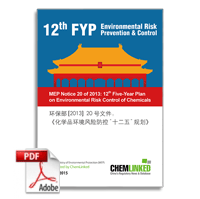
English version available!
12th Five-Year Plan on Environmental Risk Control of Chemicals
The MEP’s “FYP for environmental risk control of chemicals” did not only establish 58 categories of chemicals under particular control, the potentially affected industries and companies during the next five years are also highlighted. Apart from the industries of “petroleum refining, coking and nuclear fuel processing”, “chemical materials and products manufacturing”, “pharmaceutical manufacturing”, “chemical fiber manufacturing”, “nonferrous metal smelting and calendaring” and textile, the novel “coal-to-chemicals” industry has been confirmed to be particularly prevented and controlled. Furthermore, companies involved in the manufacture, use, storage and discharge of hazardous chemicals (HC) will be identified as the target for particular control as well if they potentially pose environmental risks.
The 7 major industries were classified into several sub-industries, the detailed description of the products involved are listed in the FYP and the GB/T 4754-2011, “Industrial classification for national economic activities”. The detailed sub-industries under control and their identification codes in GB 4754-2011 are listed below:
Petroleum refining, coking and nuclear fuel processing industry: crude oil processing (2511), coal coking (2520);
Chemical materials and products manufacturing industry: inorganic acid manufacturing (2611), inorganic base manufacturing (2612), inorganic salt (2613); manufacturing of organic chemical materials (2614); nitrogen fertilizer manufacturing (2621), phosphorus fertilizer manufacturing (2622), potash fertilizer manufacturing (2623), compound fertilizer manufacturing (2624), chemical pesticide manufacturing (2631), manufacturing of biopesticide and microbial pesticide (2632), painting manufacturing (2641), manufacturing of printing inks and analogues (2642), pigment manufacturing (2643), dyestuff manufacturing (2644), manufacturing of sealing stuff and analogues (2645), manufacturing of primary processed plastic and synthetic resin (2651), synthetic rubber manufacturing (2652), Monomers and/or polymer of Synthetic fibers (2653), manufacturing of chemical reagent and additives (2661), manufacturing of specialty chemicals (2602), manufacturing of forest chemical (2663), manufacturing of Photographic chemicals (2644), gelatin manufacturing (2666), manufacturing of soap and synthetic detergent (2681);
Pharmaceutical manufacturing industry: Chemical API manufacturing (2710);
Chemical fiber manufacturing industry: chemical pulp manufacturing (2811), manufacturing of artificial fiber/ cellulose fiber (2812), manufacturing of polyamide fiber (2821); manufacturing of polyester fiber (2822), manufacturing of acrylic fibers (2823), vinylon fibre (2824);
Nonferrous metal smelting and calendaring industry: copper smelting (3211), lead and zinc smelting (3212), cobalt-nickel smelting (3213), antimony smelting (3215), aluminium smelting (3216), magnesium smelting (3217), gold smelting (3221), silver smelting (3222), Tungsten- molybdenum smelting (3231), rare earth metal smelting (3232), manufacturing of nonferrous metal alloy (3240);
Textile industry: dyeing and finishing of cotton (1713), dyeing and finishing of synthetic fabrics (1752), dyeing and finishing of wool (1723), dyeing and finishing of silk;
Novel coal chemical industry: coal-to-oil, coal-to-gas, coal-to- olefin, coal-to-DME, coal-to- glycol;
The relevant chemical companies will be identified as target for particular control if falling into any one of the categories below:
Companies with major hazardous installation (determined by the GB 18218 -2009, “Identification of major hazard installations for dangerous chemicals”) while manufacturing, using and storing highly toxic HCs;
HC manufacturers and/or users producing heavy emissions of characteristic pollutants, while not equipped with sufficient waste processing facilities or incapable of efficient environmental risks control;
Companies located in densely populated areas or the neighborhood are considered environmental protection area, such as water source protection area, intake of water plants, aquatic living things breeding area and spawning grounds, natural fishing grounds, wetlands, cropland reserves;
HC manufacturing/utilizing companies with high environmental accidents occurrence rate or frequently complained by the public;
China MEP will formulate guidance of environmental risk assessment for the 7 industries and investigate the status of the industries and companies. Tougher industry access will be introduced to the above industries and companies. The HC companies will be evaluated whether they are environmental compliant before qualifying for other licenses such as environmental management registration, safe use permit, operating permit. 80% of the particular-controlled companies will be required to register their HCs and report the release & transfer of their characteristic pollutants. New construction, expansion of HC relevant facilities in the “sensitive area” will be halted and the established facilities will be relocated. Furthermore, clean production will be compulsorily implemented upon the particularly-controlled industries and companies stepwise.














